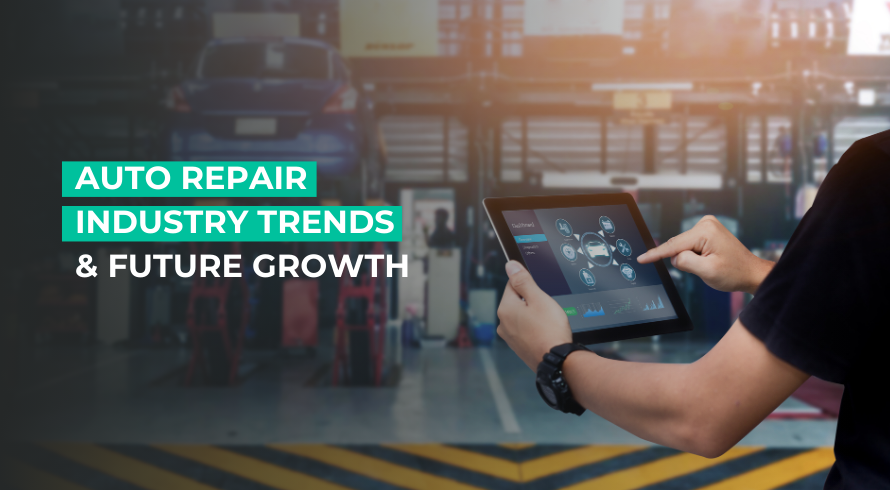The past few years have been nothing short of a roller coaster ride for the automotive industry.
From labor strikes in the United States, declining EV sales, persistent supply chain disruptions, and even rising material costs.
What was once a stable and influential industry is now struggling to come to terms with a rapidly shifting landscape. But technological advancements and enhanced environmental awareness have led players to adapt and evolve.
These have directly impacted the auto repair industry. Let’s explore how the auto repair industry is evolving, breaking down each stat.
Global automotive repair and maintenance market: Size and growth projections
Despite the many challenges, the automotive repair and maintenance sector is witnessing robust growth. The auto repair market size was valued at just over $800 Billion in 2023. In 2024, it grew to over $900 Billion. It is projected to grow to $1800 Billion by 2032, at a compound annual growth rate (CAGR) of 10.5%.

So what’s driving these numbers?
- Increased vehicle sales: In recent years, with inflated disposable incomes and a preference for a convenient mode of transportation, vehicle sales have gone up. With more cars on the road, naturally, there is an increased need for repair and maintenance services.
- Average age of vehicles: Where there is an increase in vehicle sales, there’s also an increase in the average age of vehicles. People are holding onto their vehicles more than ever before. Older vehicles require repair and maintenance. But, with major advancements in technology, users are able to maintain their vehicles efficiently.
- Growth of electric vehicles (EV): There is a sizeable shift towards electric vehicles. This opens up new opportunities for auto repair shops to offer specialized services tailored to advanced technology.
US auto repair market size
The US auto repair market, in comparison, was valued at $83 billion in 2023. In just 10 years, it is expected to grow to $134 billion by 2033.
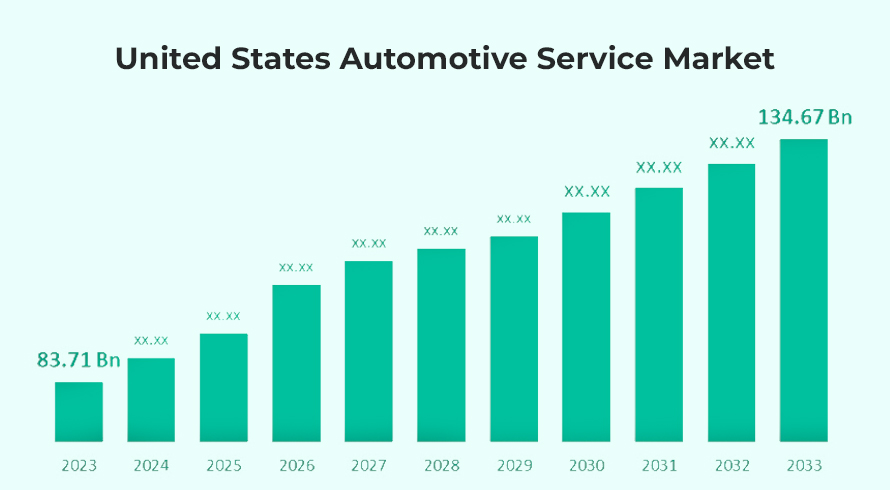
What factors are contributing to this growth?
- Ageing vehicles: the average age of vehicles is 12.6 years in the United States. This is a record high. Due to economic pressure, people prefer these cost-saving options. They want to keep their old vehicles and invest in repair and servicing rather than buy a new vehicle. This increases the demand for repair and servicing.
- Demand for shared mobility: There is an increasing demand for shared mobility in recent years. This means there’s a rise in yearly spending on maintenance of cabs or shared vehicles because of the greater distance covered.
- Growing automotive sector: the growth in the automotive sector, from design, production, and sales, to marketing and maintenance, will contribute to the growth of the automotive repair market. Auto repair is a major component of the auto sector. It ensures the functionality and safety of the vehicles on the road. Hence any growth in the automotive industry will lead to growth in the auto repair industry.
- Penetration of EVs: There is a rise in demand for the repair and maintenance of EVs as compared to ICE (internal combustion engines). But the repair and maintenance costs for EVs are expected to be 40% lower than ICE.
No wonder the number of auto repair establishments has also risen in the past few years.
In the last quarter of 2023, there were 174,169 auto repair establishments in the United States. According to the Olympian, there are about 53 automotive and maintenance establishments per 100,000 people.
And how many people are employed in the auto repair industry?
Roughly over 1 million Americans are employed in these auto repair establishments as of 2024.
This is a strong indicator of the growth the auto repair industry has experienced in the past few years. And where it is headed in the next 10 years in the United States alone.
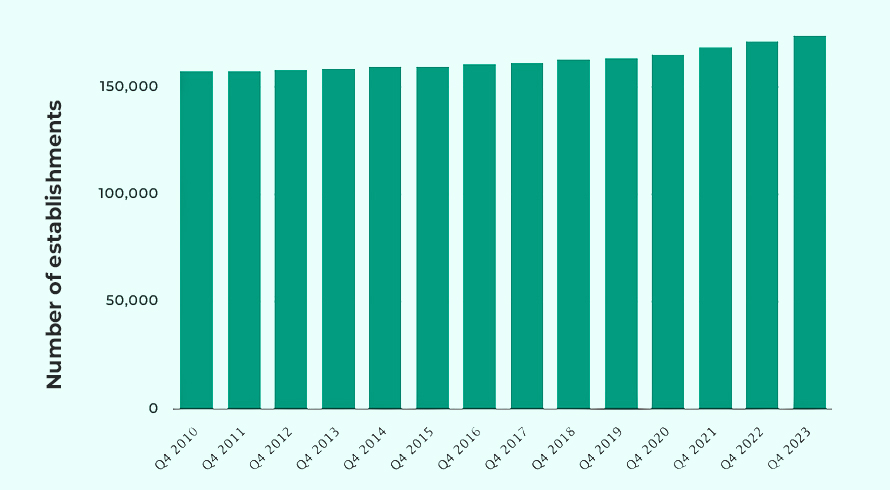
Auto repair industry trends and insights
People are buying older vehicles
We’ve already seen how people are holding onto their vehicles.
But, what is even more interesting?
People are buying older cars instead of buying new vehicles. As per industry experts, there is a projected increase in the sales of used cars. Used car sales grew by around 9% between 2019 and 2025.
Again, this indicates a prolonged lifespan of cars on the road. What does this mean? There is a steady demand for repair and servicing of old cars.
Growing focus on preventative maintenance
Vehicle owners now want to invest in the long-term use of their vehicles. This led to an increase in preventative maintenance services. From oil changing and tire replacement to brake services, vehicle owners invest in regular maintenance instead of going for costly repairs. These regular inspections prove to be more cost-effective.
Going a step further, we have predictive maintenance. This uses ‘advanced analytical techniques and data gathering tools’ to predict when a vehicle needs maintenance before failure.
The global automotive predictive maintenance market is expected to grow at a CAGR of 18% between 2023 and 2032. From $22 billion in 2023, it will reach $100 billion by 2023.
This can offer major cost savings of about 40% as compared to reactive maintenance, and 12% as compared to preventative maintenance.
Rise of mobile mechanics
In recent years, there’s been an increase in mobile mechanics. Mobile mechanics provide vehicle maintenance and car repair services at any location. Auto repair professionals go to their customers, making them an extremely convenient option for busy vehicle owners.
This is turning out to be a great option for vehicle owners who do not want to go to an auto repair shop. Hence has gained popularity.
The mobile mechanic segment grew by 15% in the past year.
Increase in EV adoption
EV sales grew by 16% in 2024 as compared to 64% in 2023 in the United States. Although EV sales have experienced a slowdown, there is still a major shift in the market. Push from the government on more environmentally friendly modes of transportation will continue.
This means that auto repair shops need to offer repair and maintenance services such as battery diagnostics and replacements for EVs in addition to ICE. Auto repair shops also need to invest in training their technicians for EV-specific jobs.
Because despite the current slowdown, EVs will surpass ICE by 2036.
It comes as no surprise.
The global electric vehicle maintenance market will grow from $18 billion in 2023 to over $84 billion by 2033.
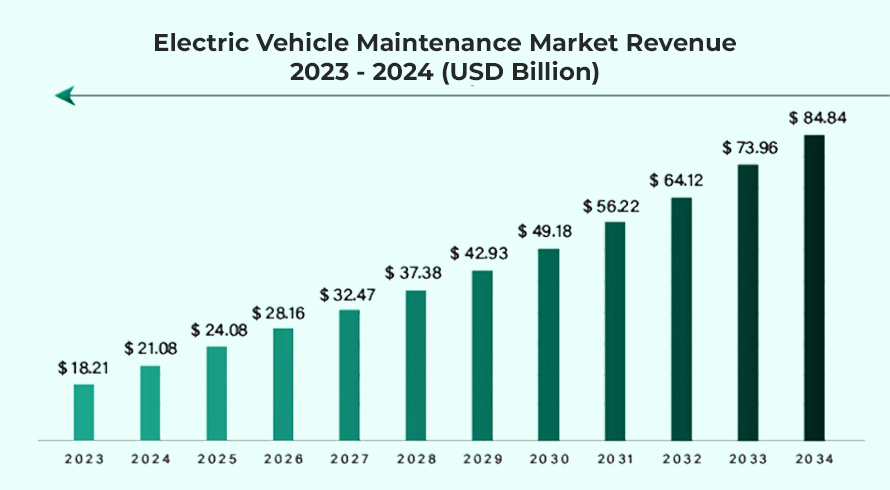
Consumer Trends in the Auto Repair Industry
Service frequency
Today, more than 40% of vehicle owners need reactive maintenance instead of routine maintenance.
Vehicle owners come in for oil changes, brake repairs, and tire rotations most often.
Spending patterns
Overall, the average cost of car maintenance in the United States is about $1,400. But the spending varies based on the type of car, region, and age of the vehicle owner.
- Consumers in the West spend the most on maintenance and repairs, averaging $1,338.
- California, Colorado, and Utah were three of the five states with the highest repair costs.
- A small Sedan might cost about $1,300 per year.
- A medium SUV can cost upwards of $1,500 per year.
Consumers in the age of 35-44 had the biggest increase in vehicle maintenance and repair (at about 51%). This is because this demographic has more disposable income to spend on auto repair and maintenance. In comparison, the ones under 25 had the smallest spending increase.
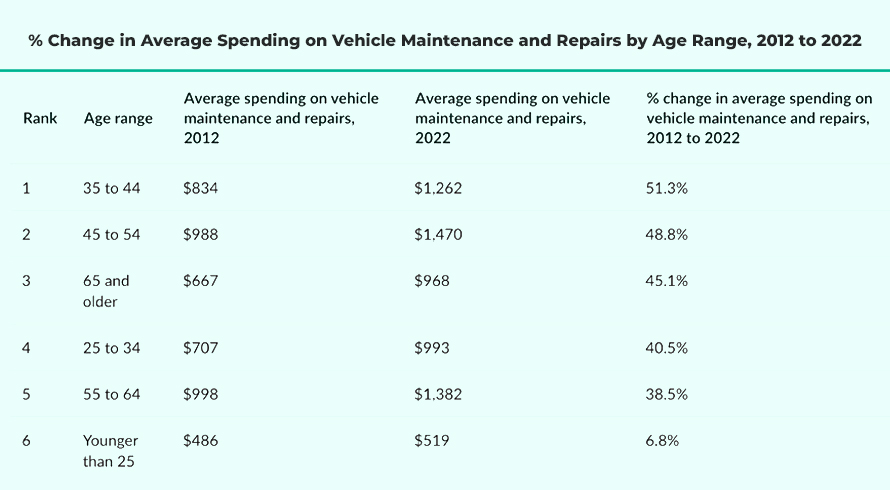
CarEdge compares the five-year maintenance costs of various brands, Toyota is the cheapest at $1,780. Nissan is at $2,408 and is the most expensive car to maintain over five years. Other brands are more expensive over five years in comparison:
- Chevrolet: $2,954
- GMC: $3,169
- Ford: $3,353
- Jeep: $3,393
- Ram: $7,254
Challenges faced by the auto repair industry
Despite the growth, the auto repair industry is facing a few challenges.
Skilled labor shortage: One of the biggest challenges is the shortage of skilled labor in the auto repair industry. This is because:
- The industry has evolved and now requires highly skilled individuals.
- Fewer people are interested in the automotive industry. They have moved away from vocational careers.
- People are retiring or changing professions, which will open up around 67,000 new jobs for auto technicians and mechanics by 2032.
- There is a negative perception attached to the industry which discourages young people from taking on this profession.
Technological disruptions: Automotive technology is changing rapidly. Auto shops need to keep updating their equipment and also train their staff for new technologies. They need a special focus on EVs and autonomous vehicles.
Economic factors: Inflation, rising labor and parts costs, and supply chain disruptions have impacted profitability for the auto repair industry. Consumers have also become price-sensitive. They want flexible payment options and competitive pricing.
The future of auto repair
Looking ahead, the auto repair industry is expected to grow globally to over $1800 billion. This growth goes hand in hand with the growth in the auto industry.
- Advanced technology: Moving forward there will be faster and more efficient diagnosis of vehicle issues with AI and IoT. It will help auto repair shops improve services, and enhance customer satisfaction and daily operations.
- Demand for repair services: As we’ve seen the average age of vehicles is 12 years, while some vehicles are also on the road for 15 years. The consumer prefers to repair their existing vehicle rather than buy a brand-new one.
- Widespread use of auto repair software: Auto repair software is widely being used across shops to help manage appointments, technicians, invoicing, parts ordering and so much more. This will further streamline daily operations and help auto shops improve customer service.
With these accelerated changes happening in the auto repair industry, it is clear that the industry will continue to grow globally as well as in the United States.




